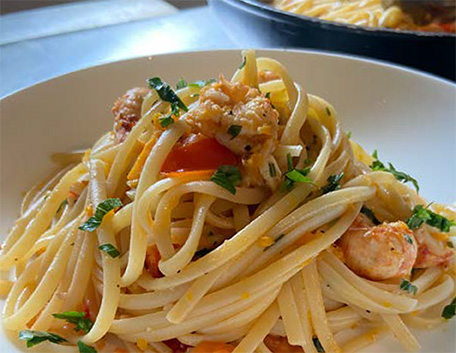News Articles
World Food Tour with Judi Love
The Lure of Crayfish
Wild crayfish are a tasty delicacy right up there with wild venison, boar and salmon as a sustainable alternative to farmed meat.
Wild sourced food is considered superior to farmed in many food delicacies – think of wild game such as venison, boar, partridge and hare, along with wild salmon, trout, and prawns amongst others. Wild equates to more flavour, better texture and more satisfaction from knowing what you are eating had a happier life. A new returner to this canon is the crayfish. Caught in a British chalk stream and humanely processed, wild crayfish are exotic, sustainable, eco-friendly candidates for starter or main course menus.
Anna Fidler, Product Development Lead at The Kennet Crayfish Company, explains that chilled, not frozen, wild crayfish can be used in the same way as large prawns or langoustines. With such sweet meat, simplicity is key: eat cooked fresh crayfish naked with mayonnaise and a dash of lemon juice, or gently toss them through pasta with some sautéed garlic, fresh tomatoes, chilli, parsley and olive oil. In addition to Italian restaurants for pasta dishes, they are also popular in Chinese, Mexican, gastropub and US southern states style dishes, and a three-star Michelin Star restaurant uses them for foam.
HABITAT
Crayfish are a delicious, smaller, freshwater cousin of the lobster, but they are bad news for other river dwellers and the river environment, as Signal crayfish, the ones we eat, are an invasive species. They come from North America and carry a virus to which native crayfish have no defence, plus they predate the eggs and young of fish and invertebrates – so us eating them is good news for the environment.
In colder months wild crayfish become less active, living in torpor close to hibernation; for this period they hide under rocks and tunnel into riverbanks, up to a metre, often undermining the bank so that it collapses and silts up the river. So, they have seasonal availability – between June and the end of the year. Keeping the numbers down, much like we do with wild deer, boar and rabbits, reduces the amount of damage they do, in this case to wildlife, fauna, flora and the river environment.
The Kennet Crayfish Company can only realistically keep the numbers for wild crayfish down in one river, The Kennet, but this is an important chalk stream, one of only 200 in the world, that provides a unique habitat of nutrient rich water for a wide range of fish, fauna and riverbank dwellers, including otters and kingfishers.
How the crayfish are processed is strictly proscribed and licensed, including keeping them in covered tanks because they are largely nocturnal and prefer to live in the dark sheltered under rocks, and keeping them throughout in water from the river Kennet, for which special licences are granted.
RECIPES
Anna Fidler is an International cook, food-writer and restaurateur and has catered for hundreds of guests at weddings and events from the Home Counties to Italy and Jamaica, worked as a cookery demonstrator for brands such as Aga, Everhot and Wolf, set up restaurants and a deli, written cookbooks and provided food on location for music videos and photo shoots. Anna linked up with The Kennet Crayfish Company in 2024 to develop recipes for wild crayfish from the River Kennet.
Crayfish are a versatile delicacy with growing popularity, and the Kennet Crayfish Company website has recipes for Pad Thai with crayfish, some prawn-based classics such as crayfish cocktail and potted crayfish, and some simple dipping sauces for crayfish. To make use of the shells, there’s a lovely recipe for crayfish bisque and Kennet’s YouTube channel shows how to make a Cajun-inspired Louisiana Boil. Look out for more recipes pairing crayfish with Italian style pasta, Chinese rice dishes and other ideas as they are developed.
Crayfish Linguine With Chilli And Parsley
Serves: 4
Ingredients:
Approximately 400g linguine (100g per person)
A little olive oil
1 red chilli, deseeded and chopped
2 garlic cloves, finely chopped
5–6 tbsp soffritto – this adds a depth of flavour to the dish but can be omitted for the sake of speed!
A dozen or so small cherry tomatoes, cut in half
Splash of white wine
Approximately 300g cooked crayfish meat (tail and claw)
Large handful flat leaf parsley, finely chopped
Small squeeze of lemon (optional)
Salt and pepper to taste
Method:
-
Bring a large pan of salted water to the boil and add the linguine. Give it a good stir and boil for 1 minute less than the pack says. Stir well occasionally so it does not stick.
-
Meanwhile, heat a little olive oil with the chilli and garlic in a pan large enough to hold all the pasta comfortably. Cook the chilli and garlic very gently until they start to sizzle, add the soffritto then turn up the heat and add the white wine. Simmer until the wine begins to evaporate. Stir through the cherry tomatoes and cook for a couple of minutes. Remove from the heat and add the crayfish meat and parsley with a sprinkling of salt.
-
When the pasta has had its cooking time, taste a strand – it should have a very slight bite. Transfer the pasta into the sauce using tongs.
-
Stir everything together well, adding a splash of pasta water if it gets claggy. Taste for seasoning and add lemon, salt or pepper if needed. Serve immediately.
Soffritto
A little olive oil
A little butter (optional)
2 large onions, finely chopped
2–3 celery stalks, finely chopped
1 large carrot, finely chopped
2 bay leaves (optional)
1 rosemary stalk (optional)
-
Heat the oil and butter in a heavy-based frying pan over a low heat. Tip in all the vegetables and herbs and gently cook until soft and sweet, about 8–10 minutes, stirring regularly.
-
Known as mirepoix in France and the ‘holy trinity’ in Cajun and Creole cuisine, this is the classic mix of onion, celery and carrot that brings the flavour base of a wide variety of dishes. The ratio is always 2-part onion to 1-part celery and 1-part carrot. Different countries have slight variations on the theme; the ‘holy trinity’ uses red, yellow or orange bell peppers instead of carrots and some cooks add aromatics such as bay leaves, rosemary and parsley stalks to the mix.
-
The key is to gently cook all the ingredients in a mix of olive oil and butter without colouring or browning the vegetables — this releases sweeter, deeper notes of flavour. You can batch cook and freeze soffritto in small freezer bags — flatten out the mixture so it is easy to break off what you need, even from frozen.



